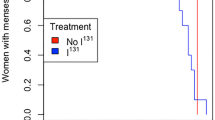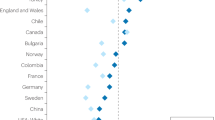Abstract
Cancer is the second-commonest cause of death in women under 40 years of age in Western Europe and the US. The survival of cancer patients has, nevertheless, improved during the past two decades. During this period, and especially during the last decade, there have been ground-breaking advances in the optimization of the quality of life of patients treated for cancer, in particular by the development of fertility-enhancing and fertility-preserving procedures in young patients treated for cancer. Surgery, chemotherapy and radiation therapy affect the fertility potential of women in different ways. Surgery to remove the uterus and ovaries has a direct impact on fertility. Radiation therapy (external or brachytherapy) can affect ovarian and also uterine function. Different drugs used in chemotherapy can directly influence ovarian function. Some markers have now been evaluated that are predictive of the potential toxic injury to the gonads and uterus. Various procedures have been proposed to preserve the fertility potential in women before anticancer treatment begins or after the tumor is treated; however, such optimization of management should only be undertaken if it does not have a deleterious effect on the survival of the patient.
Key Points
-
Alkylating agents are known to be the most toxic chemotherapeutic drugs with respect to gonadal function
-
Inhibin B, estradiol and anti-Müllerian hormone are good predictive markers of ovarian function
-
Measurement of uterine myocontractility is a good marker of uterine alteration after radiation therapy and correlates with the dose delivered
-
Conservative surgery can be used to preserve fertility in selected patients treated for gynecological malignancies
This is a preview of subscription content, access via your institution
Access options
Subscribe to this journal
Receive 12 print issues and online access
$209.00 per year
only $17.42 per issue
Buy this article
- Purchase on Springer Link
- Instant access to full article PDF
Prices may be subject to local taxes which are calculated during checkout
Similar content being viewed by others
References
Jemal A et al. (2006) Cancer statistics, 2006. CA Cancer J Clin 56: 106–130
Lee SJ et al. (2006) American Society of Clinical Oncology recommendations on fertility preservation in cancer patients. J Clin Oncol 24: 2917–2931
Shimada M et al. (2006) Ovarian metastasis in carcinoma of the uterine cervix. Gynecol Oncol 101: 234–237
Creasman WT et al. (1987) Surgical pathologic spread patterns of endometrial cancer. A Gynecologic Oncology Group Study. Cancer 60: 2035–2041
Benjamin I et al. (1999) Occult bilateral involvement in stage I epithelial ovarian cancer. Gynecol Oncol 72: 288–291
Critchley HO and Wallace WH (2005) Impact of cancer treatment on uterine function. J Natl Cancer Inst Monogr 34: 64–68
Meirow D and Nugent D (2001) The effect of radiotherapy and chemotherapy on female reproduction. Human Reprod Update 7: 535–543
Chiarelli AM et al. (1999) Early menopause and infertility in females after treatment of childhood cancer diagnosed in 1964–1988 in Ontario, Canada. Am J Epidemiol 150: 245–254
Larsen EC et al. (2003) Reduced ovarian function in long-term survivors of radiation- and chemotherapy-treated childhood cancer. J Clin Endocrinol Metab 88: 5307–5314
Bath LE et al. (2003) Depletion of ovarian reserve in young women after treatment for cancer in childhood: detection by anti-Müllerian hormone, inhibin B and ovarian ultrasound. Hum Reprod 18: 2368–2374
Sklar CA et al. (2006) Premature menopause in survivors of childhood cancer: a report from the Childhood Cancer Survivor Study. J Nat Clin Invest 98: 890–896
Jones AL (2006) Fertility and pregnancy after breast cancer. Breast 15 (Suppl 2): S41–S46
Elis A et al. (2006) Fertility status among women treated for aggressive non-Hodgkin's lymphoma. Leuk Lymphoma 47: 623–627
Franchi-Rezgui P et al. (2003) Fertility in young women after chemotherapy with alkylating agents for Hodgkin and non-Hodgkin lymphomas. Hematol J 4: 116–120
Faddy MJ et al. (1992) Accelerated disappearance of ovarian follicles in the mid-life: implications for forecasting menopause. Hum Reprod 7: 1342–1346
Haie-Meder C et al. (1993) Radiotherapy after ovarian transposition: ovarian function and fertility preservation. Int J Radiol Oncol Biol Physics 25: 419–424
Bath LE et al. (1999) Ovarian and uterine characteristics after total body irradiation in childhood and adolescence: response to sex steroid replacement. Brit J Obstet Gynaecol 106: 1265–1272
Holm K et al. (1999) Ultrasound B-mode changes in the uterus and ovaries and Doppler changes in the uterus after total body irradiation and allogenic bone marrow transplantation. Bone Marrow Transplant 23: 359–363
Corson SL et al. (1999) Inhibin-B as a test of ovarian reserve for infertile women. Hum Reprod 14: 2818–2821
Hall JE et al. (1999) Inhibin A and inhibin B reflect ovarian function in assisted reproduction but are less useful at predicting outcome. Hum Reprod 14: 409–415
Creus M et al. (2000) Day 3 serum inhibin B and FSH and age as predictors of assisted reproduction treatment outcome. Hum Reprod 15: 2341–2346
Bancsi LF et al. (2000) Basal follicle-stimulating hormone levels are of limited value in predicting ongoing pregnancy rates after in vitro fertilization. Fertil Steril 73: 552–557
Vigier B et al. (1984) Production of anti-Müllerian hormone: another homology between Sertoli and granulosa cells. Endocrinology 114: 1315–1320
Eldar-Geva T et al. (2005) Dynamic assays of inhibin B, anti-Müllerian hormone and estradiol following FSH stimulation and ovarian ultrasonography as predictors of IVF outcome. Hum Reprod 20: 3178–3183
Baarends WM et al. (1995) Anti-Müllerian hormone and anti-Müllerian hormone type II receptor messenger ribonucleic acid expression in rat ovaries during postnatal development, the estrous cycle, and gonadotropin-induced follicle growth. Endocrinology 136: 4951–4962
Durlinger AL et al. (2002) Regulation of ovarian function: the role of anti-Müllerian hormone. Reproduction 124: 601–609
Weenen C et al. (2004) Anti-Müllerian hormone expression pattern in the human ovary: potential implications for initial and cyclic follicle recruitment. Mol Hum Reprod 10: 77–83
De Vet A et al. (2002) Antimüllerian hormone serum levels: a putative marker for ovarian aging. Fertil Steril 77: 357–362
Fanchin R et al. (2003) Serum anti-Müllerian hormone is more strongly related to ovarian follicular status than serum inhibin B, estradiol, FSH and LH on day 3. Hum Reprod 18: 323–327
Fanchin R et al. (2005) High reproducibility of serum anti-Müllerian hormone measurements suggests a multi-staged follicular secretion and strengthens its role in the assessment of ovarian follicular status. Hum Reprod 20: 923–927
Gougeon A (1996) Regulation of ovarian follicular development in primates: facts and hypotheses. Endocr Rev 17: 121–155
Haie-Meder C et al. (2004) Consequences of brachytherapy on uterine myocontractility. Radiother Oncol Suppl 71: S54
Morice P et al. (2000) Ovarian transposition for patients with cervical carcinoma treated by radio-surgical combination. Fertil Steril 74: 743–748
Yamamoto R et al. (2001) A study of risk factor for ovarian metastases in stage IB-IIB cervical carcinoma and analysis of ovarian function after a transposition. Gynecol Oncol 82: 312–316
Morice P et al. (2006) Borderline tumor of the ovary and fertility. Eur J Cancer 42: 149–158
Basille C et al. (2006) Impact of gonadotropins and steroid hormons on borderline ovarian cells. Hum Reprod 21: 3241–3245
Fortin N et al. (2007) Impact of infertility drugs after treatment of borderline ovarian tumors: results of a retrospective multicenter study. Fertil Steril 87: 591–596
Chopin N et al. (2006) Radical vaginal trachelectomy and laparoscopic pelvic lymphadenectomy: an international series. Int J Gynecol Cancer 16 (Suppl 3): 602
Morice P et al. (2005) Conservative treatment of epithelial ovarian cancer: results of a French multicenter study of the GCCLCC (Groupe des Chirurgiens de Centres de Lutte Contre le Cancer) and SFOG (Societe Française d'Oncologie Gynécologique). Hum Reprod 20: 1379–1385
Roberts JE and Oktay K (2005) Fertility preservation: a comprehensive approach to the young woman with cancer. J Natl Cancer Inst Monogr 34: 57–59
Blumenfeld Z and Eckman A (2005) Preservation of fertility and ovarian function and minimization of chemotherapy-induced gonadotoxicity in young women by GnRH-a. J Natl Cancer Inst Monogr 34: 40–43
Ataya K et al. (1995) Luteinizing hormone-releasing hormone agonist inhibits cyclophosphamide-induced ovarian follicular depletion in rhesus monkeys. Biol Reprod 52: 365–372
Pereyra Pacheco B et al. (2001) Use of GnRH analogs for functional protection of the ovary and preservation of fertility during cancer treatment in adolescents: a preliminary report. Gynecol Oncol 81: 391–397
Lobo R (2005) Potential options for preservation of fertility in women. N Engl J Med 353: 64–73
Oktay K et al. (2006) Letrozole reduces estrogen and gonadotropin exposure in women with breast cancer undergoing ovarian stimulation before chemotherapy. J Clin Endocrinol Metab 91: 3885–3890
Trounson A and Mohr L (1983) Human pregnancy following cryopreservation, thawing and transfer of an eight-cell embryo. Nature 305: 707–709
Lassalle B et al. (1985) Human embryo features that influence the success of cryopreservation with the use of 1,2 propanediol. Fertil Steril 44: 645–651
Cohen J et al. (1985) Pregnancies following the frozen storage of expanding human blastocysts. J In Vitro Fert Embryo Transf 2: 59–64
Mukaida T et al. (2003) Vitrification of human embryos based on the assessment of suitable conditions for 8-cell mouse embryos. Hum Reprod 13: 2874–2879
Mukaida T et al. (2003) Vitrification of human blastocysts using cryoloops: clinical outcome of 223 cycles. Hum Reprod 18: 384–391
Vanderzwalmen P et al. (2003) Vitrification of human blastocysts with the Hemi-Straw carrier: application of assisted hatching after thawing. Hum Reprod 18: 1504–1511
Stehlik E et al. (2005) Vitrification demonstrates significant improvement versus slow freezing of human blastocysts. Reprod Biomed Online 11: 53–57
Chen SU et al. (2005) Observational clinical follow-up of oocyte cryopreservation using a slow-freezing method with 1,2-propanediol plus sucrose followed with ICSI. Hum Reprod 20: 1975–1980
Porcu E et al. (1997) Birth of a six healthy children after intracytoplasmic sperm injection of cryopreserved human oocytes. Hum Reprod 68: 724–726
Porcu E et al. (2000) Clinical experience and applications of oocyte cryopreservation. Mol Cell Endocrinol 169: 33–37
Kuleshova L et al. (1999) Birth following vitrification of a small number of human oocytes: case report. Hum Reprod 14: 3077–3079
Yoon TK et al. (2000) Pregnancy and delivery of healthy infants developed from vitrified oocytes in a stimulated in vitro fertilization-embryo transfer program. Fertil Steril 74: 180–181
Yoon TK et al. (2003) Live births after vitrification of oocytes in a stimulated in vitro fertilization-embryo transfer program. Fertil Steril 79: 1323–1326
Katayama KP et al. (2003) High survival rate of vitrified human oocytes results in clinical pregnancy. Fertil Steril 80: 223–224
Antinori M et al. (2007) Cryotop vitrification of human oocytes results in high survival rate and healthy deliveries. Reprod BioMed Online 14: 72–79
Barritt J et al. (2007) Report of four donor-recipient oocyte cryopreservation cycles resulting in high pregnancy and implantation rates. Fertil Steril 87: 189–197
Callejo J et al. (2001) Long-term ovarian function evaluation after autografting by transplantation with fresh and frozen-thawed human ovarian tissue. J Clin Endocrinol Metab 86: 4489–4494
Oktay K et al. (2004) Embryo development after heterotopic transplantation of cryopreserved ovarian tissue. Lancet 363: 837–840
Donnez J et al. (2004) Livebirth after orthotopic transplantation of cryopreserved ovarian tissue. Lancet 364: 1405–1410
Meirow D et al. (2005) Pregnancy after transplantation of cryopreserved ovarian tissue in a patient with ovarian failure after chemotherapy. N Engl J Med 353: 318–321
Acknowledgements
We thank Lorna Saint Ange for editing the manuscript.
Author information
Authors and Affiliations
Corresponding author
Ethics declarations
Competing interests
The authors declare no competing financial interests.
Rights and permissions
About this article
Cite this article
Morice, P., Pautier, P., Fanchin, R. et al. Therapy Insight: fertility in women after cancer treatment. Nat Rev Endocrinol 3, 819–826 (2007). https://doi.org/10.1038/ncpendmet0675
Received:
Accepted:
Issue Date:
DOI: https://doi.org/10.1038/ncpendmet0675
This article is cited by
-
Female fertility and colorectal cancer
International Journal of Colorectal Disease (2008)



